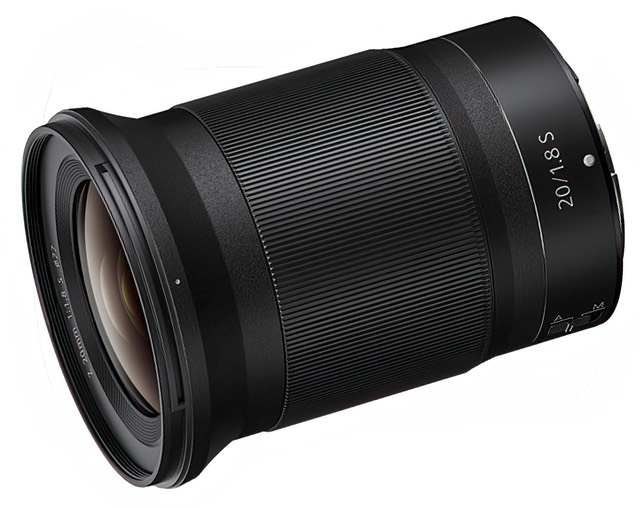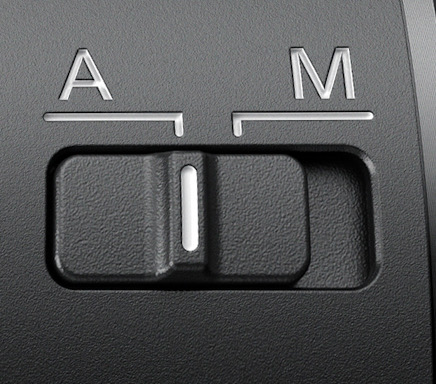
What is It?
The 20mm f/1.8 S is the fifth in Nikon's non-exotic, but high-quality prime lens series for the Z mount cameras. Other focal lengths that are available are 24mm, 35mm, 50mm, and 85mm. I’ve reviewed all of the f/1.8 S lenses now.
The question some ask at this point is whether there will be any additional f/1.8 S lenses. Certainly Nikon has left space at the wide end for 14mm, 16mm, or 18mm models, there’s a gap where a 28mm is missing, and many would welcome a 105mm or 135mm version at the telephoto end. My belief is that a 135mm f/1.8 S (and possibly DC or another technology) will be the 135mm now in the Road Map, so it’s quite possible that we could end up with eleven models in the f/1.8 S lineup.
If it seems to you that each new f/1.8 prime gets bigger, that's basically true (the 20mm is even larger than the 24mm). The 20mm f/1.8 S is 4.3” (108.5mm) long and has a 3.4” (3.4mm) diameter up front (tapered up from a barrel that is mostly 2.8" (~70mm) from the lens mount forward). At almost 18 ounces (505g), the lens isn't light, either.
By comparison, the Sony 20mm f/1.8G is 3.3” in length, 3” in diameter, uses a 67mm filter size, weighs only 13.2 ounces (373g), has an extra control ring and a Fn button. This is one of the things that leads to the “Sony is better” comments. Optically, the Nikkor and the Sony produce nearly identical final image results; it’s really only in the smaller physical characteristics that the Sony excels over the Nikkor.

As with other f/1.8 primes for the Z system, there's only one control, an A/M focus switch. Most of the front of the barrel is a really wide and has a difficult-to-miss fly-by-wire focus ring. Nikon supplies an HB-95 petal type lens hood that bayonets onto the lens. The hood can be reversed, but that significantly widens the front of an already wide lens when do that, meaning the lens needs a larger slot in your camera bag than you'd expect for a 20mm prime.
The front filter size is 77mm. Nikon seems to have no respect for filter consistency any more. In just the f/1.8 S lineup we now run 77mm, 72mm, 62mm, 62mm, 67mm. So, if you carry a full set of Nikkor f/1.8 S primes you need four filter sizes or one 77mm filter size and three step-up rings. A sad miss for a company that used to pride itself on not burdening the photographer with a proliferation of filter sizes.
Inside the lens we find a somewhat complex 14 element design in 11 groups, with three of those elements being aspherical and three being ED glass. I write “somewhat complex” because most primes tend to be simpler in optics, and the 20mm f/1.8 S also features Nikon’s multi-focus system where two motors are moving different element groups. Nano coating helps reduce internal flare, while fluorine coating keeps the front element cleaner. The lens is weather-sealed quite well, as seems to be the case with all Z lenses so far. A nine-blade aperture diaphragm sits inside, but like many faster Nikon lenses, be aware that f/16 is the minimum aperture.
Minimum focus is a bit less than 10" (0.2m), which produces a not particularly exciting 1:5.2 maximum magnification ratio. I was hoping for a little bit better than that, but most users aren't going to find this an issue.
The 20mm f/1.8 S is made in China (as is the lens hood; the lens caps are made in Thailand) and sells for US$1050.
Note that there is new firmware for this lens that allows the Z6 II, Z7 II, and Z9 cameras to program a different linear response for the focus ring.
Source of the reviewed lens: purchased (also compared to borrowed 20mm f/1.8 S)
How's it Handle?
As with the other f/1.8 S-line primes, there's not a lot to comment about in handling. My primary issue is with the slippery nature of the plastic at the camera end of the lens coupled with the really wide focus ring. This makes mounting and unmounting the lens from the camera less sure handed than it should be.
At the front end, the click-on bayonet lens hood is just loose enough on my sample to want to unmount itself any time it gets caught on something.
The new linear focusing choices make manually focusing the lens much more likable.
How's it Perform?
Focus: Snappy. Better than many of the other f/1.8 S lenses. That double motor system coupled with light mass of the moving elements definitely works.
Focus breathing is present, but at modest levels that generally won't impact anything other than an extreme focus pull. Even for focus stacking, the breathing is minimal enough to not really cause issues.
Sharpness: In normal chart testing wide open things aren't bad at all. Just the opposite, actually. I'd judge the center to be excellent, and even out through the DX corners the lens is staying in the excellent- range. It's really only as you near the FX corners that things start to blur. Note that I wrote blur, not smudge. I suspect this is field curvature at close distances.
Stopping down one stop to f/2.8 improves things significantly. The DX corners now are clearly excellent, while the FX corners start to get well into the good+ range. This improvement continues out through f/4. Diffraction blur clearly starts to occur on the 45mp bodies at f/8 and beyond, and f/11 is about the point where I wouldn't go beyond on the current high-pixel-count bodies.
At infinity (or near infinity) the performance degrades slightly. The center remains excellent wide open, but the DX corners show a bit more blur and I'd rate them only at very good-, while the far FX corners definitely have a blur to them that seems slightly directional, and can only be said to be fair+. However, stopping down once again improves things very quickly. At f/4 the DX corners have clear snap and are bordering on excellent, plus the edges start coming into clarity and I'd call them very good. f/8 actually seems to be the best choice for really long distance (f/5.6 is best for more near subjects).
At minimum focus distance, the lens does slightly better than at infinity. The DX corners are good+ wide open and are excellent by f/4. Ditto the FX corners, though they only get to very good.
The good news continues in other respects: while there's a tiny amount of field curvature, it's only apparent at the widest apertures; I'd judge it to be ignorable for most uses. Only in a few instances where I was flat on to an architectural wall at modest distances wide open did I see curvature start to be an issue. That would be an unusual composition.
No focus shift appeared that I can see in normal use, which is good, given that many of you will be using the 20mm f/1.8 S at apertures smaller than f/5.6. There's a tiny bit of focus shift at the closest focus distance, though, so beware of that if you're beyond f/5.6.
Coma is well handled wide open, and virtually nonexistent stopped down. Spherical aberrations are still present, however, but minimally so. For astrophotography work, expect stars in the extreme corners to have some very minor "shape" to them, but not enough so as to be problematic.
Linear Distortion: A modest amout of mustache barrel distortion (about 2%). Barrel distortion across about 2/3rds the image area that weakens into a final uplift out at the FX corners. Nikon's correction leaves a very small amount of barrel distortion that most would ignore.
Vignetting: While darkening is strong in the extreme FX corners, the image circle that's mostly unaffected is quite large. The 2 stop or so vignetting wide open looks more like corner clipping in normal use than traditional light falloff. Vignetting stays present as you stop down—from f/2.8 onward it remains about a stop—but again it appears only in the corners. In camera corrections don't fully correct the vignetting, though by f/4 I'd say the results are highly usable.
Chromatic Aberration: As expected from a fast, prime lens, a large amount of longitudinal CA is present, and it's still present at f/4. You really need to get down to f/6.3 or so to see it become negligible. High contrast edges—e.g. trees against sky—will definitely show the usual purple/magenta issues wide open. Lateral CA is extremely well corrected.
Flare: Well handled, Nikon. Veiling glare is minimal, and bright point lights in the frame or at the edges produce such minimal flare you might not notice it.
Bokeh: Clear onion rings are present, with only a modest edge brightening that can take on color (due to Longitudinal CA). Cats eye rounding starts near the DX boundary, but surprisingly doesn't get worse as you move out to the FX corners. Instead, the cats eye just changes shape slightly.
Compared to the Sony 20mm f/1.8G: it’s really difficult to distinguish differences between the two lenses. The Sony is a little sharper in the center, a little less sharp in the extreme corners when used at f/1.8. To me, the big issue with the Sony is that the vignetting is more severe than the Nikon (and remember Sony will record lens corrections into the raw data if enabled), and it is much more prone to flare, including colored ghosts.
Final Words
It took me longer than usual to commit to this review, as the long distance (infinity focus) results surprised me a bit. I wanted to sample additional copies of the lens before making my assertions there, and that took awhile before I could get to it. Note that I wouldn't say that this at all precludes the 20mm f/1.8 S use as a landscape lens. You shouldn't be focusing at infinity for a landscape image! For landscape work I found the 20mm f/1.8 S to be an extremely good choice, and it's significantly better than the F-mount version at infinity. However, if you're focus stacking, you might see issues in the FX corners you need to work through (at least with the Adobe software).
One thing that has to be repeated is that the Sony 20mm f/1.8G is significantly smaller than the Nikon 20mm f/1.8 S. The Sony also features an aperture ring, making it more interesting for video work. From an optical standpoint, both lenses are excellent, though I'd tend to judge the Sony as slightly better in the corners at distance, worse closer in. The large Nikkor lens size is a bit of a bummer once you see the Sony. Because of that, I'm still looking for a Z-mount lens of this focal length that is more "carry-able".
Compared to the F-mount 20mm f/1.8G, there's no question that the Z-mount version is clearly and obviously better, from center to corners, and at all apertures. My F-mount version has been kicked to the curb, where it was picked up by a dealer doing recycling.
Recommended (2021 to present)
Support this site by purchasing from the following advertiser:
